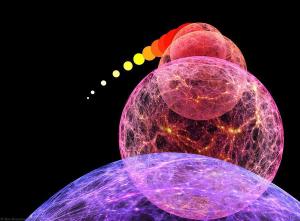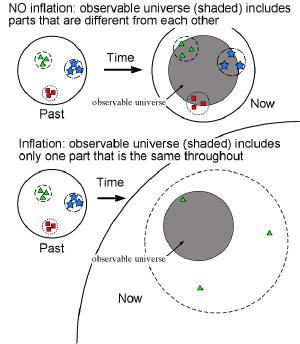Blog
Too Quiet
9 July 2014
 Don Dixon
Don DixonIn the big bang model, the universe began about 13.8 billion years ago as a hot, dense state. There’s plenty of observational evidence to support this model. One strong bit of evidence is the cosmic microwave background (CMB). It is the thermal remnant of the primordial fireball, cooled now to a temperature of about 2.7 K. What’s amazing about the CMB is how perfectly it light matches that of a blackbody. It is exactly what you would expect to see from a primordial universe of uniform temperature. But that also raises a bit of a mystery, because the CMB is actually more uniform that it should be.
With the COBE, WMAP and Planck satellites, we’ve made very detailed maps of the cosmic microwave background. We see it radiating from all directions in the sky, and in all directions it has the same temperature, with only small variations. Across the entire sky, the CMB only varies to within 1 part in 10,000. It is effectively uniform. But according to simple big bang models, it shouldn’t be.
 Nick Strobel
Nick StrobelThe CMB we observe is the first light when the universe finally became transparent. When the universe was about 380,000 years old, it finally cooled to the point that the charged particles (by then mostly nuclei and electrons) united to form atoms of hydrogen and helium. With this union light was no longer heavily scattered and absorbed, and so this earliest light of the universe began a journey across the cosmos. But at that time, the observable universe was about 10 million light years across. So there was no way for regions of space on opposite ends of the observable universe to interact with each other. There certainly wasn’t time for their temperatures to equalized.
You can get an idea of this effect if you imagine a cold room with a space heater. When you first turn on the heater, the air around the heater gets warm, but the rest of the room is still cold. Eventually the heat spreads to the entire room, but that takes time. If you came back 5 minutes after turning on the heater, you’d be surprised if the entire room was warmer by a couple degrees. This is what we see with the cosmic microwave background. Somehow the temperature became uniform before it had time to become uniform.
The most popular solution to this problem is known as inflation. Basically it proposes that the universe was much, much smaller in its earliest moments, so that there was plenty of time for temperatures to even out. The universe then entered a period of rapid inflation, before leveling off to its current rate of expansion. This model not only solves the horizon problem, but also others such as the flatness problem and the lack of magnetic monopoles. It also has the advantage of building upon known physics. We know that the universe is currently expanding, so inflation simply proposes a mechanism to change that rate.
Of course, having a theoretical solution that explains it all isn’t enough for a scientific model. It needs to be supported by observational or experimental evidence, and that’s a huge challenge. There is a way we could observe the effects of inflation, and that is by observing a pattern in the CMB known as B-mode polarization. This is what BICEP2 may have observed. But as we’ve seen with BICEP2, there are other sources of B-mode polarization, and they might be strong enough to mask any effect from inflation. While the BICEP2 clearly observed B-mode polarization, they haven’t ruled out the possibility that it is due to dust. Other teams, such as Planck are working to observe the effects of inflation, but we’re still waiting for those results.
Since the inflation model solves the horizon problem and others so well, it is generally thought to be the correct solution. Most astrophysicists figure it is just a matter of gathering enough data to detect its effects, at which point we can start nailing down the details of inflation in the early universe. But it is also pretty clear that dust and other contaminating sources are a real problem. It’s generally thought that we can overcome those problems, but there are some astronomers who think that dust and other sources are so strong that it may be impossible to observe the inflation signal with any certainty.
If that’s the case, what then? What if we have a theoretical model that works, but have no way to confirm its validity? Is it enough to rely on theory alone? Or would this mark a shift away from science and more into philosophy?
Next Time: Black holes are very real, and very very strange.